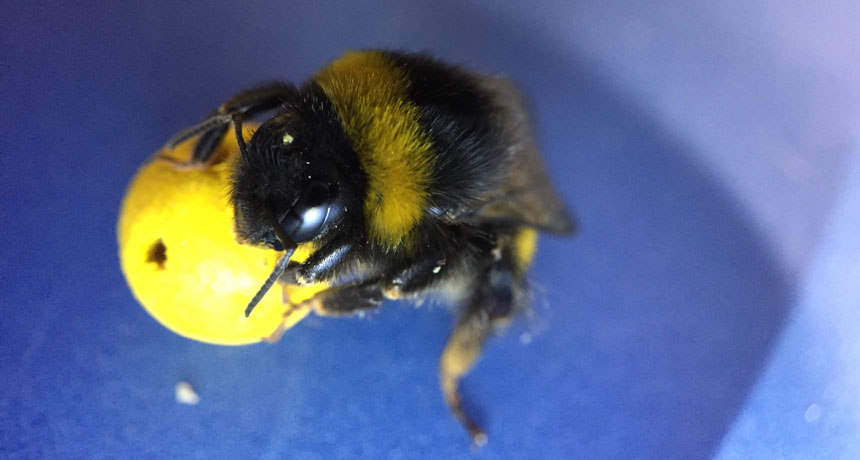
PLAY BALL A buff-tailed bumblebee rolls a yellow ball toward a goal as researchers explore just how odd a task bees can learn and how much observing others helps them succeed.
Iida Loukola/QMUL
Even tiny brains can learn strange and tricky stuff, especially by watching tiny experts.
Buff-tailed bumblebees got several chances to watch a trained bee roll a ball to a goal. These observers then quickly mastered the unusual task themselves when given a chance, researchers report in the Feb. 24 Science. And most of the newcomers even improved on the goal-sinking by taking a shortcut demo-bees hadn’t used, says behavioral ecologist Olli Loukola at Queen Mary University of London.
Learning abilities of animals without big vertebrate brains often get severely underestimated, Loukola says. “The idea that small brains constrain insects is kind of wrong, or old-fashioned.”
He and colleagues had previously challenged bees to learn, in stages, the not very beelike skill of pulling a string to reveal a hidden flower. Bees eventually succeeded. So the researchers devised an even more fiendish protocol to see how far insect learning could go.
Loukola invented six-legged sort-of soccer (or football for bees in London) in which a Bombus terrestris rolls a yellow ball about the size of its own body down a trackway to a central goal, where researchers dispense sugary rewards. This time, there was no pampering, no working up in stages to full completion of the test. But bees could observe a trained ball roller, a ball moving on its own (thanks to a researcher sliding a magnet under the arena) or get no advance ball-movement hints at all.
The 10 bees that saw an expert bee roll the ball and score three times before their own attempt succeeded in almost every trial at the task. Watching ghostly movement didn’t help as much, and only a few bees happened on the solution on their own. Social learning matters, but Loukola highlights the way bees changed the technique they watched. Most of the successful bees ignored the ball they had seen rolled and instead used one closer to the goal, doing less work for the same reward.
Story continues after video
BUMBLEBEES SCORE In experiments, buff-tailed bumblebees learned how to roll a ball to a goal (first clip), a task more bees mastered after watching a trained bee do it (second clip). When successful, bees received a sip of sugar solution as a reward. O.J. Loukola et al/Science 2017 |
“Fascinating,” says Dave Goulson of the University of Sussex in England, who studies bumblebees. Ball rolling may not be part of routine foraging behavior, but he notes that bees do drag around nesting material, moving backward as they do when playing soccer in the test. And they occasionally remove fat almost ball-like grubs from the nest with a similar technique.
Exactly how the bees solved the problem remains a puzzle, says Bennett Galef of McMaster University in Hamilton, Canada, who has studied social learning. He would like to know more details, for instance, about how untrained bees react to a ball.
Loukola often gets a different question: Could he train bumblebees to play a soccer match? He says he could certainly train some to score on one side of an arena and some on the opposite side. Then he might be able to study whether bumblebees could share a ball.






